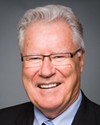Yes, just to put a finer point on it.
I think this is an important comment. The preliminary results that we're seeing from the evaluation are showing us that 95% of the beneficiaries of the economic development initiative have increased their capacity in their business or in their community.
Denise already mentioned the leveraging. She was too modest. The leveraging is also another important point. When you look at the regular leveraging for BDP, the program we use on the non-commercial side, it's about 25%. But with this initiative, we leveraged, as Denise said, almost double what we invested, which means that we were the catalyst for these communities to generate new partnerships and new investments for new initiatives.
We also see in the preliminary results that over a thousand businesses increased their capacity for training, their knowledge of financial statements, for instance, and their knowledge on being able to access international markets. These are important things for communities.
We also see that about 75 communities reinforced their capacity to coordinate partnerships with other community groups. Again, this is an important thing in minority communities: they need to be able to find strength in numbers when they're in a minority situation.
I could go on, but for us, I think those are some of the more important general benefits that we're seeing. We could talk about the specific benefits that specific projects have achieved.
Denise mentioned the translation project. We've seen hundreds of companies translate some of their products so that a greater number of people are aware of their products and they can increase their sales. We've seen, for instance, that Le Pays de la Sagouine in Bouctouche attracted more people. This increased their revenues. It helps the small community of Bouctouche. Those are real, concrete, tangible results that have come from this initiative.
Thank you for the question.





